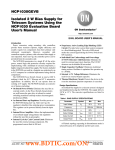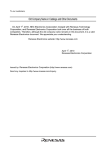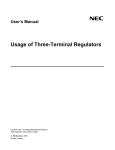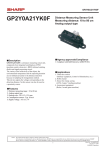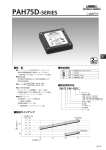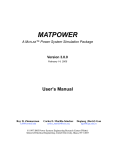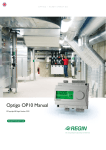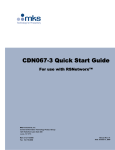Download μPC3033,3005 - Electrocomponents
Transcript
DATA SHEET BIPOLAR ANALOG INTEGRATED CIRCUIT μ PC3033,3005 LOW-SATURATION STABILIZED POWER SUPPLY WITH ON/OFF FUNCTION (OUTPUT CURRENT: 1 A) DESCRIPTION The μPC3033 and 3005 are low-saturation type regulators with an output current of 1 A at respective output voltages of 3.3 V and 5 V. These regulators are also provided with an ON/OFF function, which reduces the dissipation when there is no load, making them ideal for systems requiring low power consumption. Since output voltage accuracy is as high as ±1%, it can respond also to the application of which high precision is required. FEATURES PIN CONFIGURATION (Marking Side) • ON/OFF pin for output control (active-high) • Output voltage accuracy: VO = ±1% (when TA = 25°C) • Output current capacitance: 1 A <R> • Low dropout voltage: VDIF = 0.6 V MAX. (at IO = 0.5 A) • On-chip inrush current protection circuit for when input voltage rises (when input voltage is low level) 1 2 3 4 • On-chip overcurrent and thermal protection circuit APPLICATIONS 1: INPUT 2: ON/OFF 3: GND 4: OUTPUT Digital TV, Audio, Air conditioner, etc. ORDERING INFORMATION Part Number μPC3033H μPC3033H-AZ Note μPC3005H μPC3005H-AZ Note Package Marking Output Voltage 4-pin plastic SIP (TO-126 ) C3033 3.3 V 4-pin plastic SIP (TO-126 ) C3033 3.3 V 4-pin plastic SIP (TO-126 ) C3005 5V 4-pin plastic SIP (TO-126 ) C3005 5V Note Pb-free (This product does not contain Pb in external electrode.) The information in this document is subject to change without notice. Before using this document, please confirm that this is the latest version. Not all products and/or types are available in every country. Please check with an NEC Electronics sales representative for availability and additional information. Document No. G17372EJ2V0DS00 (2nd edition) Date Published January 2006 NS CP(K) Printed in Japan The mark <R> shows major revised points. The revised points can be easily searched by copying an "<R>" in the PDF file and specifying it in the "Find what:" field. 2006 μ PC3033,3005 BLOCK DIAGRAM INPUT ON/OFF circuit ON/OFF Reference voltage + − Error amp. Drive circuit OUTPUT Saturation protection Start-up circuit Thermal shut down Over current protection GND 2 Data Sheet G17372EJ2V0DS μ PC3033,3005 ABSOLUTE MAXIMUM RATINGS (TA = 25°C, unless otherwise specified.) Parameter Symbol Rating Unit VIN −0.3 to +8.0 V VON/OFF −0.3 to +8.0 V PT 12.5 W Operating Ambient Temperature TA −40 to +85 °C Operating Junction Temperature TJ −40 to +150 °C Storage Temperature Tstg −55 to +150 °C Thermal Resistance (Junction to Ambient) Rth(J-A) 110 °C/W Thermal Resistance (Junction to Case) Rth(J-C) 10 °C/W Input Voltage ON/OFF Pin Voltage Internal Power Dissipation (TC = 25°C) Note Note Internally limited. When the operating junction temperature rises over 150°C, the internal circuit shuts down the output voltage. Caution Product quality may suffer if the absolute maximum rating is exceeded even momentarily for any parameter. That is, the absolute maximum ratings are rated values at which the product is on the verge of suffering physical damage, and therefore the product must be used under conditions that ensure that the absolute maximum ratings are not exceeded. TYPICAL CONNECTION ON/OFF D1 μ PC3033, μ PC3005 INPUT OUTPUT + CIN COUT D2 CIN: 0.1 μF or higher. Set this value according to the length of the line between the regulator and INPUT pin. Be sure to connect CIN to prevent parasitic oscillation. Use of a film capacitor or other capacitor with excellent voltage and temperature characteristics is recommended. If using a laminated ceramic capacitor, it is necessary to ensure that CIN is 0.1 μF or higher for the voltage and temperature range to be used. COUT: 10 μF or higher. Be sure to connect COUT to prevent oscillation and improve excessive load regulation. Place CIN and COUT as close as possible to the IC pins (within 1 to 2 cm). Also, use an electrolytic capacitor with low impedance characteristics if considering use at sub-zero temperatures. D1: If the OUTPUT pin has a higher voltage than the INPUT pin, connect a diode. D2: If the OUTPUT pin has a lower voltage than the GND pin, connect a Schottky barrier diode. Caution Ensure that voltage is not applied to the OUTPUT pin externally. Data Sheet G17372EJ2V0DS 3 μ PC3033,3005 RECOMMENDED OPERATING CONDITIONS Parameter <R> Input Voltage Symbol VIN <R> ON/OFF Pin Voltage <R> Corresponding Model MIN. TYP. MAX. Unit μPC3033 4.3 7.5 V μPC3005 6.0 7.5 V VON/OFF All 0 VIN V Output Current IO All 0 1.0 A Operating Ambient Temperature TA All −40 +85 °C Operating Junction Temperature TJ All −40 +125 °C Caution Use of conditions other than the above-listed recommended operating conditions is not a problem as long as the absolute maximum ratings are not exceeded. However, since the use of such conditions diminishes the margin of safety, careful evaluation is required before such conditions are used. ELECTRICAL CHARACTERISTICS μPC3033 (TJ = 25°C, VIN = 5 V, VON/OFF = 5 V, IO = 0.5 A, CIN = 0.1 μF, COUT = 10 μF, unless otherwise specified.) Parameter Output Voltage Symbol VO1 VO2 TYP. MAX. Unit 3.267 3.3 3.333 V (3.366) V (3.234) REGIN 4.3 V ≤ VIN ≤ 6 V 2.0 9.0 mV Load Regulation REGL 5 mA ≤ IO ≤ 1 A 10.0 66.0 mV Quiescent Current IBIAS1 IO = 0 A 2.0 4.0 mA IBIAS2 IO = 0.5 A 15.0 30.0 mA IBIAS(S) VIN = 3.1 V, IO = 0 A 9.0 25.0 mA Vn 10 Hz ≤ f ≤ 100 kHz 80 μVr.m.s. dB Output Noise Voltage <R> −20°C ≤ TJ ≤ +70°C, IO = 50 mA MIN. Line Regulation Startup Quiescent Current <R> Conditions Ripple Rejection R·R f = 120 Hz, 4.3 V ≤ VIN ≤ 6 V 59 Dropout Voltage VDIF IO = 0.5 A 0.4 Short Circuit Current IOshort Peak Output Current IOpeak 1.0 ΔVO/ΔT 0°C ≤ TJ ≤ 125°C ON Voltage VON VIN = 7 V, IO = 0 A OFF Voltage VOFF VIN = 7 V, IO = 0 A Temperature Coefficient of Output 0.6 V 0.6 A 1.5 A ⏐0.16⏐ mV/°C Voltage ON/OFF Pin Current (ON state) Standby Current ION/OFF VON/OFF = 5 V IBIAS(OFF) VON/OFF = 0 V 2.0 V 85 0.8 V 200 μA 10 μA Remark Values in parentheses have been measured during product design and are provided as reference values. 4 Data Sheet G17372EJ2V0DS μ PC3033,3005 μPC3005 (TJ = 25°C, VIN = 6 V, VON/OFF = 6 V, IO = 0.5 A, CIN = 0.1 μF, COUT = 10 μF, unless otherwise specified.) Parameter Output Voltage Symbol VO1 VO2 −20°C ≤ TJ ≤ +70°C, IO = 50 mA TYP. MAX. Unit 4.95 5.0 5.05 V (5.10) V (4.90) REGIN 6 V ≤ VIN ≤ 7 V 2.0 9.0 mV Load Regulation REGL 5 mA ≤ IO ≤ 1 A 20.0 66.0 mV Quiescent Current IBIAS1 IO = 0 A 2.0 4.0 mA IBIAS2 IO = 0.5 A 18.0 30.0 mA IBIAS(S) VIN = 4.8 V, IO = 0 A 9.0 25.0 mA Vn 10 Hz ≤ f ≤ 100 kHz 120 μVr.m.s. 54 dB Startup Quiescent Current Output Noise Voltage Ripple Rejection R·R f = 120 Hz, 6 V ≤ VIN ≤ 7 V Dropout Voltage VDIF IO = 0.5 A Short Circuit Current IOshort <R> Peak Output Current IOpeak <R> Temperature Coefficient of Output <R> MIN. Line Regulation <R> <R> Conditions 0.28 1.0 ΔVO/ΔT 0°C ≤ TJ ≤ 125°C ON Voltage VON VIN = 7 V, IO = 0 A OFF Voltage VOFF VIN = 7 V, IO = 0 A 0.6 V 0.6 A 1.5 A ⏐0.4⏐ mV/°C Voltage ON/OFF Pin Current (ON state) Standby Current ION/OFF VON/OFF = 7 V IBIAS(OFF) VON/OFF = 0 V 2.0 V 130 0.8 V 200 μA 10 μA Remark Values in parentheses have been measured during product design and are provided as reference values. Data Sheet G17372EJ2V0DS 5 μ PC3033,3005 TYPICAL CHARACTERISTICS (TA = 25°C) Δ VO vs.TJ Pd vs. TA 30 Δ VO - Output Voltage Deviation - mV Pd - Total Power Dissipation - W 15.0 With infinite heatsink 12.5 10°C/W 10.0 7.5 5.0 110°C/W Without heatsink 2.5 1.1 0.0 0 25 50 75 85 100 125 IO = 5 mA 20 10 μ PC3033 0 -10 -20 -30 μ PC3005 -40 -50 -60 -70 150 -50 -25 0 25 50 75 VO vs. VIN (μ PC3033) VO vs. VIN (μ PC3005) 5.0 6.0 TJ = 25°C 4.0 VO - Output Voltage - V VO - Output Voltage - V TJ = 25°C 3.0 IO = 5 mA IO = 0.5 A IO = 1 A 2.0 1.0 5.0 4.0 IO = 5 mA 3.0 IO = 0.5 A IO = 1 A 2.0 1.0 0.0 0.0 0 1 2 3 4 5 6 7 8 0 1 VIN - Input Voltage - V IBIAS (IBIAS(s)) vs. VIN (μ PC3033) IBIAS - Quiescent Current - mA 50 IO = 1 A 30 IO = 0.5 A 10 4 5 6 7 8 IBIAS (IBIAS(s)) vs. VIN (μ PC3005) 60 20 3 80 TJ = 25°C 70 40 2 VIN - Input Voltage - V 80 IO = 5 mA 0 TJ = 25°C 70 60 IO = 1 A 50 40 30 IO = 0.5 A 20 10 IO = 5 mA 0 0 1 2 3 4 5 6 7 8 VIN - Input Voltage - V 6 100 125 150 TJ - Operating Junction Temperature - °C TA - Operating Ambient Temperature - °C IBIAS - Quiescent Current - mA <R> 0 1 2 3 4 5 6 VIN - Input Voltage - V Data Sheet G17372EJ2V0DS 7 8 μ PC3033,3005 VDIF vs. TJ (μ PC3005) IO peak vs. VDIF (μ PC3005) 1.8 IO = 0.5 A 0.7 0.6 0.5 0.4 0.3 0.2 0.1 IO peak - Peak Output Current - A VDIF - Dropout Voltage - V 0.8 0 TJ = 25°C 1.6 1.4 1.2 1.0 0.8 0.6 0.4 0.2 0.0 -50 -25 0 25 50 75 0.0 100 125 150 TJ - Operating Junction Temperature - °C 70 70 60 50 40 30 TJ = 25°C IO = 0.5 A VIN = 4.3 ~ 6.0 V R•R - Ripple Rejection - dB R•R - Ripple Rejection - dB 80 2.0 2.5 3.0 3.5 60 50 40 30 20 TJ = 25°C IO = 0.5 A VIN = 6.0 V 10 0 0 10 100 1000 10000 100000 10 f - Frequency - Hz 100 1000 10000 100000 f - Frequency - Hz VDIF vs. IO (μ PC3005) VO vs. IO (μ PC3005) 1.0 6 TJ = 25°C 0.9 5 0.8 VO - Output Voltage - V VDIF - Dropout Voltage - V 1.5 R•R vs. f (μ PC3005) 80 10 1.0 VDIF - Dropout Voltage - V R•R vs. f (μ PC3033) 20 0.5 0.7 0.6 0.5 0.4 0.3 0.2 VIN = 6.5 V TJ = 25°C 4 3 2 1 0.1 0.0 0.0 0.1 0.2 0.3 0.4 0.5 0.6 0.7 0.8 0.9 1.0 0 0.2 0.4 0.6 0.8 1.0 1.2 1.4 1.6 1.8 2.0 IO - Output Current - A IO - Output Current - A Data Sheet G17372EJ2V0DS 7 μ PC3033,3005 PACKAGE DRAWING (Unit: mm) 4-PIN PLASTIC SIP (TO-126) A N E M Q D 1 4 K Y H V J U C F G M NOTE ITEM Each lead centerline is located within 0.2 mm of its true position (T.P.) at maximum material condition. A C MILLIMETERS 8.5 MAX. 1.1 MIN. D 9.7±0.3 E F G φ 3.2±0.1 0.65±0.1 H 2.0 0.2 J 1.25 MAX. K M 2.3 MIN. 11.5 MAX. N 2.7±0.2 Q 14.5 MAX. U 1.7 MAX. 0.55±0.1 V Y 13.5±0.7 P4HP-200B-2 8 Data Sheet G17372EJ2V0DS μ PC3033,3005 RECOMMENDED SOLDERING CONDITIONS The μPC3033,3005 should be soldered and mounted under the following recommended conditions. For soldering methods and conditions other than those recommended below, contact an NEC Electronics sales representative. For technical information, see the following website. Semiconductor Device Mount Manual (http://www.necel.com/pkg/en/mount/index.html) Through-hole devices μPC3033H, μPC3005H: 4-pin plastic SIP (TO-126) Process <R> <R> Conditions Wave soldering Solder temperature: 260°C or below, (only to leads) Flow time: 10 seconds or less. Partial heating method Pin temperature: 300°C or below, Heat time: 3 seconds or less (Per each pin). Recommend WS60-00-1 P300 μPC3033H-AZ, μPC3005H-AZ: 4-pin plastic SIP (TO-126) Note Process <R> <R> Conditions Wave soldering Solder temperature: 260°C or below, (only to leads) Flow time: 10 seconds or less. Partial heating method Pin temperature: 350°C or below, Heat time: 3 seconds or less (Per each pin). Recommend WS60-00-1 P350 Note Pb-free (This product does not contain Pb in external electrode.) Caution For through-hole device, the wave soldering process must be applied only to leads, and make sure that the package body does not get jet soldered. Data Sheet G17372EJ2V0DS 9 μ PC3033,3005 NOTES ON USE When the μPC3033 or μPC3005 is used with an input voltage that is lower than the value prescribed in the recommended operating conditions, a large quiescent current flows through the device due to saturation at the transistor of the output stage. The specifications of these characteristics are prescribed by the item “Startup Quiescent Current (IBIAS(S))”. These products have a saturation protector, but a current of up to 80 mA MAX. may flow through the device. Thus the power supply on the input side must have sufficient capacity to allow this quiescent current to pass through when the device is started up. REFERENCE DOCUMENTS Document Name Document No. Usage of Three-Terminal Regulators User’s Manual G12702E Semiconductor Device Mount Manual http://www.necel.com/pkg/en/mount/index.html SEMICONDUCTOR SELECTION GUIDE - Products and Packages - X13769X 10 Data Sheet G17372EJ2V0DS μ PC3033,3005 • The information in this document is current as of January, 2006. The information is subject to change without notice. For actual design-in, refer to the latest publications of NEC Electronics data sheets or data books, etc., for the most up-to-date specifications of NEC Electronics products. Not all products and/or types are available in every country. Please check with an NEC Electronics sales representative for availability and additional information. • No part of this document may be copied or reproduced in any form or by any means without the prior written consent of NEC Electronics. NEC Electronics assumes no responsibility for any errors that may appear in this document. • NEC Electronics does not assume any liability for infringement of patents, copyrights or other intellectual property rights of third parties by or arising from the use of NEC Electronics products listed in this document or any other liability arising from the use of such products. No license, express, implied or otherwise, is granted under any patents, copyrights or other intellectual property rights of NEC Electronics or others. • Descriptions of circuits, software and other related information in this document are provided for illustrative purposes in semiconductor product operation and application examples. The incorporation of these circuits, software and information in the design of a customer's equipment shall be done under the full responsibility of the customer. NEC Electronics assumes no responsibility for any losses incurred by customers or third parties arising from the use of these circuits, software and information. • While NEC Electronics endeavors to enhance the quality, reliability and safety of NEC Electronics products, customers agree and acknowledge that the possibility of defects thereof cannot be eliminated entirely. To minimize risks of damage to property or injury (including death) to persons arising from defects in NEC Electronics products, customers must incorporate sufficient safety measures in their design, such as redundancy, fire-containment and anti-failure features. • NEC Electronics products are classified into the following three quality grades: "Standard", "Special" and "Specific". The "Specific" quality grade applies only to NEC Electronics products developed based on a customerdesignated "quality assurance program" for a specific application. The recommended applications of an NEC Electronics product depend on its quality grade, as indicated below. Customers must check the quality grade of each NEC Electronics product before using it in a particular application. "Standard": Computers, office equipment, communications equipment, test and measurement equipment, audio and visual equipment, home electronic appliances, machine tools, personal electronic equipment and industrial robots. "Special": Transportation equipment (automobiles, trains, ships, etc.), traffic control systems, anti-disaster systems, anti-crime systems, safety equipment and medical equipment (not specifically designed for life support). "Specific": Aircraft, aerospace equipment, submersible repeaters, nuclear reactor control systems, life support systems and medical equipment for life support, etc. The quality grade of NEC Electronics products is "Standard" unless otherwise expressly specified in NEC Electronics data sheets or data books, etc. If customers wish to use NEC Electronics products in applications not intended by NEC Electronics, they must contact an NEC Electronics sales representative in advance to determine NEC Electronics' willingness to support a given application. (Note) (1) "NEC Electronics" as used in this statement means NEC Electronics Corporation and also includes its majority-owned subsidiaries. (2) "NEC Electronics products" means any product developed or manufactured by or for NEC Electronics (as defined above). M8E 02. 11-1













